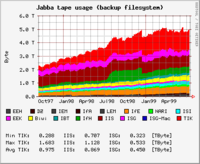RRDtool
| RRDtool
|
|
|---|---|
 Example graphic from RRDtool |
|
| Basic data
|
|
| developer | Tobias Oetiker |
| Current version |
1.7.2 ( May 27, 2019 ) |
| operating system | Unix and derivatives , Microsoft Windows |
| programming language | C. |
| category | Database management system |
| License | GPL |
| https://oss.oetiker.ch/rrdtool/ | |
RRDtool is a program with which time-related measurement data can be saved, summarized and visualized. The program was originally developed by Tobias Oetiker and licensed under the GNU General Public License (GPL). By publishing it as free software , many more authors have now contributed new functionality and bug fixes. RRDtool is available as source code and as an executable program for many operating systems.
The abbreviation RRD stands for " Round Robin Database" and refers to the way in which data is stored by RRDtool. When creating a database , a so-called "RRD file", enough memory is created for a specified period of time. After this period of time, the database is not expanded (the file is not enlarged), but the oldest data is overwritten. This “turn-around process” is also referred to as a ring buffer in computer science .
The user interface of RRDtool consists of command line programs. Programming interfaces (APIs) are available for several programming languages , including C and Perl, so that RRDtool can be used by other programs to save data and create graphs .
Usually, RRDtool is not used directly via the command line, but serves other programs as a data memory or source. Examples of FOSS programs that use RRDtool are Cacti , MRTG, and Munin . A longer list of programs that use RRDtool can be found on the RRDtool homepage.
Round robin archives
Depending on which time span is shown in a graph, data in different resolutions are required. Often there are a few spans of time that are of particular interest, such as "a day", "a week", "a month" and "a year". RRDtool takes advantage of this fact to automatically compress (summarize) data.
A "round robin archive" (RRA) is created for each desired period of time, which can hold a fixed number of data points. This space is then filled with the round robin method . Each RRA specifies a resolution which (together with the number of data points) defines the period of time for which data is saved. The “ consolidation function ” ( CF) defines how several data points are combined . The most commonly used functions are mean , minimum, and maximum .
Available versions
In November 2015 there were four stable version branches, version 1.2 with the version numbers 1.2. * To version 1.5 with the version numbers 1.5. * . In principle, only bug fixes flow into the stable version branches. However, there are occasional exceptions to this rule. Some time ago the initiator of the project called for a collection of ideas for RRDtool 2.x.
New functions in version 1.3
The following functions and improvements are in version 1.3.
- Accelerated file access through the use of memory mapped I / O .
- Using Cairo and Pango to generate graphs.
- Alternative version of the Holt-Winters algorithm .
- Support for localized help messages has been prepared.
RRD files created with version 1.3 are backwards compatible with version 1.2 , except when the new version of the Holt-Winters algorithm is used.
See also
swell
- ↑ Release 1.7.2 . May 27, 2019 (accessed May 28, 2019).
- ↑ RRD World: Projects that use RRDtool
- ↑ https://lists.oetiker.ch/pipermail/rrd-developers/2009-April/003105.html
- ↑ https://lists.oetiker.ch/pipermail/rrd-announce/2012-November/000148.html
- ↑ https://lists.oetiker.ch/pipermail/rrd-developers/2008-June/002278.html